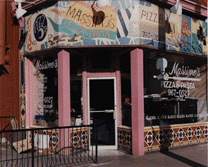![]()
|
|
|
|
|
|||||

Success Stories
Magic Assembling: Storefronts to Culture
Storefronts to Culture: A Virtual Tour of Multicultural Toronto
Not so long ago if you wanted to tour Toronto’s neighbourhoods, you’d be advised to put on a pair of sturdy walking shoes and set out early. Today, you can cover the same ground on the Information Highway, thanks to Magic Assembling: Storefronts to Culture, a colourful web site that lets you "point and click" your way around town. Your visit can start with a quick look at the easy-to-follow maps of the various areas of the city. And, as you move through layers of the skillfully constructed site, you discover a diversity of ethnocultural communities thriving side by side in Canada’s largest city.
The project was carried out under contract to Industry Canada’s SchoolNet Digital Collections program, which gives people 15 to 30 years of age entrepreneurial and technology-based job experience converting collections of Canadian material into digital form for display on SchoolNet. The SchoolNet Digital Collections web site has grown to become possibly the largest single source of Canadian content on the Information Highway.
Magic Assembling: Storefronts to Culture was conceived and constructed by a team of young people who were working as co-op students at Toronto’s TG (Today’s Generation) Magazine. Project leader Sarah Denham is a first year journalism student who admits she had few computer skills when she started out. "I didn't even know how to turn a computer on," says Denham. "And today, it’s a real liability if you’re not familiar with technology. Now that I’ve completed this project, I feel quite at home with computers and the Internet." Karishma Gabriel summed up her experience this way: "Before this project my biggest exposure to technology was the pocket calculator. Now I’m proficient in several computer programs." Other students who worked on the project included Katie Gosley, Kingsley McCart, Shelley Smarz, Denise Campbell and Jamie Barraclough.
Denham said she particularly enjoyed learning computer graphics, and she’s developed an interest in Internet publishing that she hopes will translate into a job when she graduates. "Today, all major newspapers and magazines are on-line. This project taught me how to develop and manage a web site, and this knowledge is more and more necessary for people looking at careers in journalism," she says.
Denham also enjoyed the SchoolNet Digital Collections project because it taught her more about her own hometown. "Even though I live in Toronto I had no idea how diverse it really is," she says. Denham is pleased the site was developed as an educational tool, and not merely as entertainment. "Too often the Internet barely touches the surface of issues," she explains. "We tried to be more than a shoppers’ guide to Toronto. We wanted to get beyond the storefronts, and probe the issues facing our multicultural society."
And indeed, Magic Assembling: Storefronts to Culture takes an in-depth look at the complexity of this unusual city. For example, behind the Apollo Tours and Chung Acupuncture storefront on Bloor Street, we learn how Koreans came to call Toronto home through an article about the Canadian mission movement in South Korea and the friendship that grew between Canadian missionaries and their Korean faithful. Or, step into Viking Fine Foods on Laird Drive in East York and discover an article about the emergence of the urban neighbourhood, Cabbagetown. Each storefront is the beginning of a journey of discovery into some of Toronto’s fascinating cultures.
|
Updated: |
